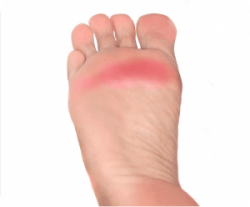Metatarsalgia is a foot condition where the ball of the foot becomes painful and inflamed. Activities that involve running and jumping may cause the condition, and it is also a consequence of poorly fitted shoes.
If you are suffering with Metatarsalgia, you may experience a sharp, burning pain in the ball of the foot, a pain that worsens when you stand, walk or flex your foot, or a sensation that feels like you are standing on a pebble in your shoe. Metatarsalgia can also cause numbness, tingling or shooting pains in the toes. You may simply need to rest and allow your feet to recover from their heavy workload, but if pain persists for more than a few days, or does not improve when you alter your footwear and modify your activities, you should see your doctor.
What Causes Metatarsalgia?
1. A tough training schedule. Those who go running regularly are more likely to develop Metatarsalgia due to the pressure on the front of the foot during running. Wearing worn out or unsupportive shoes can make the problems worse, and good quality, well-cushioned shoes should be worn for all high impact exercise.
2. Abnormalities of the foot. A foot that is an unusual shape, such as with a very high arch, or a long second toe, can put extra pressure on the metatarsals. Foot conditions that cause the foot to become deformed, such as hammertoes or bunions, can have the same effect and are often the result of of poorly fitted shoes.
3. Being overweight. When you are overweight, your feet have to work much harder to carry you around all day. Losing weight, with a healthy diet and regular exercise, may reduce or relieve symptoms of Metatarsalgia entirely.
4. Wearing the wrong shoes. Shoes are intended to protect and support your feet, and if yours don’t fit properly, they can’t do this job. Shoes that are supportive and well designed help to prevent foot problems by distributing weight evenly across the sole of the foot, avoiding pressure that can cause deformities. Visit Foot Solutions to find shoes that will support you in all the right places.
5. Stress fractures. Small breaks in the toe bones, or in the metatarsals themselves, can cause you to place your feet differently, putting pressure in the wrong places and increasing the likelihood of developing Metatarsalgia.
6. Morton’s neuroma. Morton’s neuroma is a condition where the tissues around the nerves, between the third and fourth toes, thicken and cause stress in this sensitive area of the foot. This condition can lead to Metatarsalgia, and similar pain relieving measures can be effective for both foot problems.
Great Shoes are the Best Treatment for Metatarsalgia
Wearing shoes that are designed to support your feet and that fit you well is the most important thing you can do to take care of your feet and prevent foot pain. Pop into Foot Solutions today for a free gait analysis test and find a solution that works for you and your lifestyle.
































